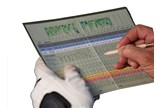Bad Golf’s John Robins: “New formats reignited my love for the game”
Last updated:
After Bad Golf’s John Robins hand was forced into breaking away from the Stableford scoring system, he stumbled upon the on-course freedom he’d been searching for.
In his exclusive monthly Today’s Golfer column, the comedian and broadcaster walks us through the surprising benefits of trying something new on the course.
Since joining a golf club for the first time just under two years ago, my handicap has been my main focus. Even though it’s basically a bit of admin, getting one does make you feel like you’re now part of the gang, whatever the number.
Then getting my handicap down became my sole aim. A run of good form and some forgiving summer fairways got me down to 12.3 last year, something I never expected and though the harsh winter conditions and endless mud of December gave it a bit of a pasting, I’m now consistently sitting around 13-14, which gives me about 16 shots on a challenging course. A nice number to play with. But has my pursuit of getting cut come at the expense of another important part of golf? Fun!

Not long after I joined a club and got my first official handicap (19 as I remember), word spread about the new fangled England Golf handicap system and app, a revolution in the way golfers in England recorded and tracked their handicap. You could now enter every card you played, on any course! Golfers worldwide could now compete on a level playing field. What’s not to like?
There were grumblings from some people I spoke to. They weren’t too keen on recording every round. ‘But why on earth not?!’ I thought, eager for as many opportunities as possible to get that number down. Well, all it took was some bad weather and three closed holes to show me why not.
Being a bit of a stats junkie, the idea of playing a round ‘for fun’, had kind of disappeared from my list of golfing priorities. Then, as so many courses have to during British winters,, my local course had to close some holes during a period of heavy rain, meaning we couldn’t hand in cards for much of December and January. More casual competitions were organised and some strange phrases began to appear on the members’ website like “Texas Scramble”, “Multiplier”, “Harlequin” and the intriguing “Putter Nutter”.
RELATED: John Robins: “How I halved my handicap in four months”
Miffed at not being able to hand in a card I signed up nonetheless, keen to keep my hand in before summer. What followed was some of the most enjoyable golf I’ve ever played.
I’d only ever played strokeplay, matchplay and stableford before, so all these new formats did take a bit of explaining (and re-explaining, and re-re-explaining) from more experienced members. I thought we might have a bit of a laugh, which we did, but I wasn’t expecting to learn so much about my game through putting it under different types of pressure.
For any other newbies (in as fewer words as I can manage), let me explain the formats.
A Texas Scramble is when you pick the best tee shot from four golfers and each play the ball from that position, repeating until it’s holed (making sure to use a minimum of four tee shots from each player over the course of the round). A multiplier is when the top three stableford scores of four players are multiplied together, so 2x2x3 = 12pts and the dreaded 3x3x0 = 0 points. A harlequin is when you have a special (usually yellow) ball between three golfers that you play on alternate holes and scores double (but if you lose it it’s gone forever). And, a “putter nutter”, well, I haven’t played it yet, but it’s when you subtract your number of putts from your stableford score.

Playing, as we do, so many individual stableford rounds, your game is always being stress-tested in the same way. What’s great about playing other formats is that I suddenly found myself with both enormous pressure and enormous freedom in ways I never usually have.
RELATED: “My Irish adventure… in 40mph winds”
Stepping up to the first tee with the harlequin ball in my hand, out of bounds left, knowing that if I lose it I’ve essentially wasted the next four hours of my team’s life, is quite the feeling. In a multiplier, seeing my mate chip in for four points only to realise if I miss a three-foot putt it will count for nothing really does test the limits of golfing comradeship. But the best of it all, was the freedom of being able to really attack pins and the short game during a Texas Scramble.
I’ve always suffered from being too tentative around, and on, the green. My putts never get to the hole and my chips, well, a fair few never make the green. But once someone has stiffed the ball from forty yards, suddenly you can feel the tension drain from your shoulders. You think ‘I can really go for this!’, and that most elusive of golfing skills, commitment, begins to rush through your shot.

Similarly I’ve always prioritised accuracy over distance with my driving (to limited success), so seeing the ball before mine bounce merrily along the fairway suddenly meant I could do something I’d never had the courage to try before…hitting the ball as hard as I can! It turns out I’m no Bryson DeChambeau, but on certain holes I was easily adding 10 or 20 yards to my drive just from knowing it didn’t matter if it went wrong. What a revelation!
I absolutely loved it. And now the greens have recovered and the holes reopened, I hope that we continue with our monthly format twists. Do we play too much stableford in this country? Maybe. And as good, convenient and accurate as the new system is, it’s worth remembering that not everything we do needs to be logged and adjusted.
Sometimes the best experiences in golf are best left on the course.
READ NEXT: Fun golf formats for you to try





